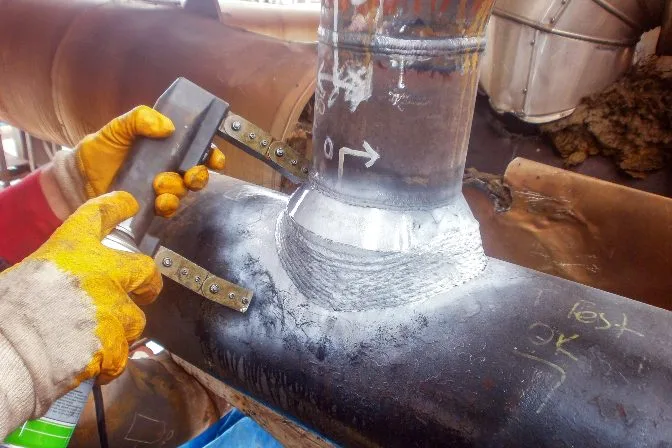A Comprehensive Overview to Comprehending Exactly How Welding Examination Functions: Techniques, Criteria, and Finest Practices for Quality Control in Metal Construction
Understanding the ins and outs of welding evaluation is crucial for maintaining the honesty of steel manufacture. Implementing best practices can dramatically improve high quality guarantee procedures. The landscape of welding assessment is not without its challenges.
Significance of Welding Inspection
Although welding is a critical procedure in numerous sectors, its integrity straight influences the safety and security and efficiency of frameworks and components. Efficient welding inspection is necessary for determining issues that might compromise the top quality and sturdiness of welded joints. This process makes certain adherence to developed requirements and specifications, which are important for preserving structural honesty and operational dependability.
Welding examination serves multiple purposes, including validating that the welding process has been performed appropriately, analyzing the quality of products used, and verifying that the completed item satisfies regulatory and market criteria (Houston Welding Inspection). Through rigorous inspection, possible problems such as porosity, splits, and insufficient blend can be discovered early, minimizing and preventing costly repair work security dangers
Additionally, constant welding evaluations foster self-confidence amongst stakeholders, consisting of designers, customers, and regulatory bodies, by demonstrating a commitment to quality control. The value of welding evaluation can not be overemphasized; it is essential not just for conformity with lawful demands however likewise for enhancing the general performance of bonded frameworks. Inevitably, a durable welding evaluation program is a positive procedure that safeguards against failures, guaranteeing the durability and reliability of welded elements in their desired applications.
Common Welding Inspection Methods

Visual inspection is the initial line of defense, enabling inspectors to identify surface area flaws such as fractures, damages, or incomplete blend. Radiographic testing utilizes X-rays or gamma rays to reveal inner problems, making it optimal for complicated welds. Ultrasonic testing uses high-frequency sound waves to identify subsurface defects, giving exact measurements of weld honesty.
Magnetic bit testing works for ferromagnetic products, highlighting surface area and near-surface discontinuities when fragments are applied to a magnetic field. On the other hand, dye penetrant screening makes use of a fluid dye to reveal surface-breaking defects, ensuring that also the smallest flaws are discovered.
Each strategy has its strengths and restrictions, typically necessitating a mix of methods for comprehensive analysis - Houston Welding Inspection. By using these examination techniques, quality control in steel construction is achieved, making sure that welded structures fulfill safety and efficiency standards
Sector Specifications for Welding


The American Welding Culture (AWS) and the American National Criteria Institute (ANSI) are two prominent organizations that establish welding criteria. AWS D1.1, for instance, outlines the needs for welding steel structures, while AWS D1.2 focuses on aluminum. Worldwide, the ISO 3834 basic addresses quality demands for fusion welding, offering a framework suitable throughout national boundaries.

Finest Practices for Top Quality Guarantee
Quality guarantee in welding is vital to achieving risk-free and sturdy building and constructions. Developing an extensive high quality administration system (QMS) tailored to the particular welding project is important.
Routine training and accreditation of welding employees are crucial for preserving a proficient workforce. Continuous education on the most up to date welding techniques and innovations guarantees that inspectors and welders are educated concerning current requirements and techniques.
In addition, carrying out pre-weld evaluations to evaluate products and equipment can protect against flaws before they occur. Houston Welding Inspection. Throughout the welding process, real-time monitoring and documents of welding specifications assist identify incongruities promptly. Post-weld inspections should entail extensive assessments making use of non-destructive testing (NDT) approaches to guarantee the integrity of the welds
Furthermore, maintaining clear interaction amongst team see this website participants advertises a culture of top quality. Routine audits and reviews of the welding procedure assistance determine areas for improvement. By adhering to these ideal techniques, organizations can attain optimal quality control, ultimately resulting in boosted safety and security and efficiency in steel construction projects.
Challenges in Welding Examination
Although welding evaluation is vital for making certain structural honesty, it offers a range of challenges that can complicate the analysis procedure. One substantial obstacle is the variability in welding strategies and materials made use of, which can affect the consistency of weld quality. Different welders may utilize differing methods, bring about inconsistencies that inspectors check that requirement to determine and evaluate.
An additional obstacle involves the discovery of flaws. Non-destructive testing (NDT) techniques, such as radiographic and ultrasonic testing, can be complex and call for knowledgeable specialists to interpret results precisely. False positives or negatives can happen, potentially leading to expensive rework or jeopardized security.
Additionally, the visibility of environmental factors, such as temperature and humidity, can affect the integrity of welds and the effectiveness of inspection methods. Examiners should also browse the governing landscape, ensuring compliance with market requirements, which can vary by territory and application.
Conclusion
Finally, welding inspection plays a crucial duty in ensuring the integrity and security of metal construction. Utilizing a range of assessment methods, sticking to established market requirements, and implementing More about the author efficient quality management practices collectively boost the integrity of welded structures. Despite the challenges dealt with in the evaluation procedure, a commitment to continual enhancement and adherence to best techniques can dramatically bolster the quality control framework, cultivating better self-confidence among stakeholders in the welding industry.
Reliable welding inspection is necessary for identifying flaws that can endanger the top quality and toughness of bonded joints.In addition, regular welding assessments foster confidence among stakeholders, including designers, clients, and governing bodies, by demonstrating a dedication to top quality guarantee.The American Welding Culture (AWS) and the American National Standards Institute (ANSI) are two famous companies that develop welding criteria. During the welding procedure, real-time surveillance and documents of welding parameters help identify variances quickly. Despite the obstacles encountered in the inspection process, a dedication to constant renovation and adherence to best methods can dramatically bolster the high quality assurance framework, cultivating higher confidence among stakeholders in the welding sector.